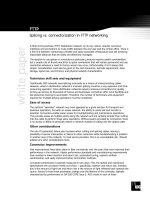get south guide book
Bạn đang xem bản rút gọn của tài liệu. Xem và tải ngay bản đầy đủ của tài liệu tại đây (12.48 MB, 160 trang )
3
Are you ready to Get South?
The gems of South America have been discovered, and they are here
waiting for you! The landscapes are awe-inspiring, the cities unique and
the culture full of passion. Think you’re ready for a fiery football match,
going mad for mate and consuming copious amounts of scrumptious
meat and wine? Want to soak up some rays on cool beaches, dive in the
Pacific or Atlantic Oceans or ski on unblemished slopes?
Well, it’s all here! Argentina, Chile and Uruguay. These three countries
lie side by side, each completely unique but together they form one of
the most exhilarating, enticing and unforgettable places to travel in the
world! The possibilities are endless… Draw yourself into the shadows
of the majestic and omnipotent snow capped Andes, hang out with a
million penguins, or be mesmerized by giant glaciers shedding chunks
of ice in a sea of rugged frozen fields.
In this vast land, you’ll also find top-notch rafting, trekking, mountain
climbing, diving, fishing, paragliding, horseback riding, mountain biking,
skiing and our personal favourite: having a good time.
Now go on Get South!
Hello! Thank you for picking up a copy of Get South, we hope it becomes
your new best friend on the road.
This year we are celebrating our 5th anniversary so this new edition
is very special to us as it marks a significant milestone in our journey.
We are a small team of independent travellers and are committed to
offering travel advice to people just like us. Every place you see in Get
South has been personally visited or recommended, so we have all the
insider tips and most recent information that sometimes is difficult to
find by yourself.
Over the years we have had help from different travel fanatics, including
travel writer Amanda Barnes who has been writing for Get South since
2010 and our Buenos Aires man Alejandro Damico who’s been helping
with the guide since 2011.
On this special anniversary I would like to thank family and friends for
all their help, love and patience throughout.
I would also like to thank our loyal advertisers without whose support
this guidebook couldn’t exist. Please continue to support our advertisers
because without them we couldn’t bring you this guide. Remember to
mention Get South so they know we helped you find them.
We love to hear from our readers,
so please drop us an email if you
have any feedback, suggestions or
just want to say hi!
Follow us on Facebook and
Twitter and keep in touch for
more Get South news. We hope
to see you on the road one day!
**
5th Year Anniversary! **
7
5th Year Anniversary!
How to use this guidebook
Getting Around
Health & Safety Tips/Visa Information
Volunteering
Responsible Travel/Trekking Tips
Popular Festivales
Don’t leave without trying these
Wines Tasting Guide
Backpacker Etiquette/Swap Offerings
Bucket List
Meet the locals
ARGENTINA
Useful Information/Distance chart
Buenos Aires
Tigre
CENTRE REGION
La Plata
Mar del Plata
Córdoba
LITORAL REGION
Rosario
Paraná
Esteros del Iberá
Posadas
San Ignacio
Puerto Iguazú
Asunción - Paraguay
CUYO REGION
Mendoza
Potrerillos
San Rafael
Malargüe
San Juan
NORTH REGION
Tafí del Valle
Amaicha del Valle
Cafayate
Salta
San Salvador de Jujuy
Purmamarca
2
4
8
9
10
11
13
14
15
16
17
18
19
20
21
31
33
34
35
36
39
40
43
44
45
46
47
49
50
51
57
58
59
60
61
62
63
64
65
72
73
-
-
-
-
-
-
-
-
-
-
-
-
-
-
-
-
-
-
-
-
-
-
-
-
-
-
-
-
-
-
-
-
-
-
-
-
-
-
-
-
-
Tilcara
Humahuaca
Iruya
La Quiaca
PATAGONIA REGION
Neuquén
San Carlos de Bariloche
El Bolsón
Esquel
Las Grutas
Puerto Madryn
Puerto Pirámides
El Chaltén
El Calafate
Puerto San Julián
Ushuaia
CHILE
Useful Information/Distance chart
Arica
Iquique
San Pedro de Atacama
La Serena
Pisco Elqui
Viña del Mar
Valparaíso
Santiago
Pichilemu
Pucón
Valdivia
Puerto Varas
Puerto Montt
Chiloe Island - Ancud
Chiloe Island - Castro
Carretera Austral
Puerto Natales
Punta Arenas
Puerto Williams
URUGUAY
Glossary
Spanish / English dictionary
Acknowledgements
74
76
78
79
80
81
82
85
88
89
91
94
95
96
100
101
105
106
108
109
111
113
114
114
115
119
123
124
127
128
131
133
135
139
140
143
144
146
150
151
152
-
-
-
-
-
-
-
-
-
-
-
-
-
-
-
-
-
-
-
-
-
-
-
-
-
-
-
-
-
-
-
-
-
-
-
-
-
-
-
-
-
*
CONTENTS
*
8
**
How to use this guidebook
**
You can get a free copy at most tourist info centres and
bus stations (of destinations featured) or throughout all the
companies displayed in the guidebook.
For detailed information check out the
“Find Get South“ section in our website!
Download Get South free of charge from our website,
or receive it by mail anywhere
in the world, just by paying postage!!
**
Where to find Get South
**
Get the most out of your Get South, see our handy tips below:
Get South promotional offers are ONLY valid when the guidebook is
shown on arrival or at check-in, and when the reservation is made
and payment received by the company providing the service. Offers
cannot be combined with any other discounts or special promotions.
Promotions are only valid with direct bookings, not through third party
service providers. When bookings are made through Hostel World,
Hostel Bookers or any other booking engine, Get South promotions
are NOT valid. Using your HI, Ho.La or any other card membership
also makes Get South promotions invalid.
Thanks for your understanding, Get South is here
to help you, and enjoy the discounts and freebies!
9
**
How to use this guidebook
**
Spanish words marked with a * have definitions in our Glosarry on page 150.
Below are the symbols and terms repeated throughout Get South:
Accommodation
Restaurant
Activity*
Travel Agency
Spanish School
Rent a Car
Bar
*Horseback riding, paragliding, skydiving,
trekking, rappelling, mountain biking, rafting.
Refers to any discount or special
promotion for Get South users
Hostel associated with
Hostelling International
Places a bit more expensive that
offer better facilities and service
Hostels offering 10% off
with Ho.La membership
The establishment accepts:
Breakfast
Internet
Wi-Fi
Parking
Free services offered by advertisers:
Social networks:
- Google Plus
- Skype
When making a booking, please be careful of different terms:
Double room: 1 double bed. In Chile called double matrimonial
Twin room: 2 separate single beds. In Chile called double twin
Dorms: shared room with multiple beds
En-suite: bathroom inside the room
Icon guide for type of company:
Credit Cards US Dollars Euros
Remember to show Get South wherever
you go so that you can get the
discounts and benets
offered in the guidebook!
Please help us spread the word about
Get South to your fellow travellers,
accommodation owners, tour guides,
operators and travel agencies.
Thanks for supporting us!
HOLA
AMIGOS!!
www.getsouth.com
11
12
:: By plane: Airlines tend to fly to and from
capital cities, with connections to most major cities
and tourist centres. Check out www.aerolineas.
com, www.lan.com, www.lade.com, www.skyairline.cl or www.flypluna.com
for details!
:: By bus: You can get virtually everywhere in South America by bus. Take a bus
for a more cost-effective and culturally thrilling experience. Overnight trips
are quite comfortable, often including meals, films, and attendant services.
:: By car: For a personalized adventure through the countryside, you can
always travel by car. Rental companies generally operate in most towns and
cities and you can save some bucks if you are travelling in a group.
:: By taxi or remis: Cheap and reliable, taxis and remises (private taxis)
provide quick transportation within city limits. Simply flag them down with an
outstretched arm, or call them in advance.
:: By local bus: Sometimes very efficient, but unless you know the city very
well, it can be a bit confusing. In Argentina they are called “colectivos”, but in
Chile this word means “shared taxi”. Local buses in Chile are called “micros”.
Please recycle me!!
If you can bear without
taking me home, leave me
for one of your friends!
**
Getting Around
**
South Pass is a travel pass for 5, 7 or 15 bus trips (regular only) in
and across Argentina, Uruguay, Chile, Brazil, Paraguay, Bolivia and Peru
over 60 consecutive days. South Pass works online so that travellers
don’t need to go to the bus station anytime before their journey.
Enter www.argentinabybus.com for more information.
13
To make sure you stay healthy and enjoy your travels, we have developed a
couple of health and safety tips:
- You can normally drink tap water, although always ask if you are unsure.
- Use sunscreen, especially at high altitude - even if it’s cold, the sun is still
strong.
- Stay streetwise as you walk around the big cities, keep to busy streets, avoid
being a target and mind your pockets/bag.
- Take taxis at night and try not to be out alone.
- If you do fall in love one night, always use protection - AIDS, HIV
and other STIs are a risk in any country with any person (heterosexuals
included).
- Keep your documents safe, make copies and save your details online in case.
- If you have any valuables, try to keep them in the hostel/hotel safe.
- Never leave valuables in a car or bus.
- Dress appropriately to not attract unwanted attention.
- Overnight buses sometimes get very cold, wrap up warm.
- Don’t change money on the street, only use recognized exchange bureaus.
**
Health & Safety Tips
**
To visit Argentina, Chile and Uruguay most
nationalities (including most of Western Europe, South Africa, New Zealand)
don’t need a visa and can enter these countries with a valid passport and receive
a free 90 day Tourist Card on arrival.
Some nationalities (including USA, Australia and Canada) are required to pay a
reciprocity fee on entry to Chile and Argentina - these can be paid on arrival
and is typically around US$130 - US$160 payable in cash (it depends on the
country). The receipt is regarded as a multiple entry visa.
Other nationalities require a visa before arriving - contact the
relevant foreign consular representative if you are unsure or
if you need to apply in advance for an entry visa.
Note: Passport and visa requirements are liable to change
at short notice. Travellers are advised to check their entry
requirements with their embassy or consulate.
**
Visa Information
**
14
Interested in making a societal impact? South America offers a number
of charitable organizations that need YOUR help!
A few hours a week can enrich your experience abroad
and can make a world of difference!
Here are only a few of many organizations operating:
ARGENTINA
• Fundación Argentina de Etoecología (www.etoecologia.org.ar) raises
environmental awareness through direct action such as forestation, ground
imporvement, water purification and education on environmental issues. You
can also volunteer with them to help children and women on the street.
• Hogar Amparo Maternal (www.amparomaternal.com.ar) works with young
mothers and their children to create a place to stay and organize their daily
tasks.
• Banco de Alimentos (www.bancodealimentos.org.ar) fights hunger and
malnutrition by providing soup kitchens and raising awareness.
• Voluntario Global (www.voluntarioglobal.com.ar) runs educational projects
in Buenos Aires, northern Argentina, Bariloche and Iguazu.
• South American Explorers (www.saexplorers.org) has a good database of
volunteer opportunities across South America for eager travellers.
CHILE
• Voluntarios de la Esperanza (www.ve-global.org) works to provide shelters,
orphanages and schools in Santiago.
• Agrupacion Medio Ambiental Torres del Paine (www.amatorresdelpaine.
org) does conservation work and environmental education in the national
park.
• Un Techo para Chile (www.untechoparachile.cl) works on reconstruction of
homes for those in Southern Chile whose
homes were devastated by earthquakes.
URUGUAY
• Karumbe (www.karumbe.org) is a
volunteer project that monitors and
conserves sea turtles in coastal Uruguay.
**
Volunteering
**
15
Travelling is a conscientious act of discovery and liberation. Still, simple steps
can (and should) be taken in order to be a responsible traveller and to avoid
undesirable incidents.
How to be a responsible traveller
• Read about the social, cultural, political, economic, and environmental
climate of your destination.
• Seek out locally owned businesses (accommodation, restaurants, etc).
• Travel in small groups and mingle with locals.
• Attempt to learn the local language.
• Be respectful of culture and customs: dress
accordingly, ask to take photographs of people, etc.
• Volunteer with local organizations.
• Travel to enjoy, not to destroy.
• Buy crafts from local artisans to assist local economic development.
• Don’t be stingy with tips, especially when visiting developing areas.
• Limit your environmental impact - don’t litter!
The key is to travel with an open mind; a desire to connect with the people and
culture you’re entering will go a long way towards creating an unforgettable journey.
**
Responsible Travel
**
:: Avoid trekking alone.
:: Pre-plan your itinerary, informing others of your route and making sure you
leave yourself plenty of daylight time.
:: Always remain on marked trails.
:: Make sure to read and obey all signs.
:: Make sure to wear and carry the appropriate gear. UV sunglasses, a
waterproof jacket, sunscreen and warm clothing are just a few to mention… if
in doubt make sure to ask a local guide. They will know best!!
:: Don’t bother the wildlife, pick up your waste and bring back only memories.
:: Never ever light a fire
under any circumstances.
:: If someone has left a mess
before you, do the right
thing and pick it up.
**
Trekking Tips
**
Trekking is one the best things to do in South America -
it’s cheap, it’s healthy and always memorable. Here are our top tips:
16
Everyone loves a good fiesta, and here are some of the highlights of festivals for
Argentina, Chile and Uruguay. These festivals are popular - so always try to book
accommodation in advance!
January
• Festival Nacional del Folklore, Cosquín, near Córdoba, late
January: This is Argentina’s largest festival for folk music. Grab
your gaucho pants and armadillo guitar for this one!
February
• Fiesta Nacional de la Pachamama, Amaicha del Valle: Celebrate
the bounty of mother nature (Pachamama) as the natives gather
to celebrate with folk music, food and drink and pick out the most
beautiful girl as their festival queen.
• Lemanja Festival of the Godess of the Sea, Montevideo and Punta del Este, 2
February: One of the major festivals in Uruguay, thousands of devotees take to the
beaches to offer watermelons, flowers and candles to the godess of the sea.
• Festival Costumbrista Chilote, Castro, Chiloe Island, 3rd week of February: This
festival celebrates the Chilote traditions with artisans, typical food, singing and music,
animal fairs and traditional games.
• Festival Internacional de la Canción, Viña del Mar: This is not only Chile’s but one
of South America’s biggest Latin American pop festivals. Everyone gets down to Viña to
see their favourite pop acts.
• Carnival, Uruguay, North Argentina (Gualeguaychu, Jujuy province), late February - early
March: Although much bigger in neighbouring Brazil, carnival is still celebrated with
due fervor in these other Southern Cone countries. The main Carnival celebrations are
in Montevideo where people dress up, dance and sing to Candombe all night long for a
couple weeks. In Jujuy people celebrate Mother Nature’s bounty by throwing a huge party
with lots of drinking, eating, singing and dancing. The devil is the mascot of the party and
locals dress up in colourful costumes as they move to the music on every street corner
and cover each other in snow spray, talcom powder, confetti and using water pistols.
March
• Vendimia, Mendoza, late February - early March:
Celebrating the wine harvest in Mendoza, this event
builds up momentum over a couple weeks culminating
in beauty parades, big theatrical performances,
folkloric music and lots of wine tasting!
**
Popular Festivals
**
17
April
. Lollapalooza, Santiago, 6th & 7th: A two day alternative rock and rap music festival
with international acts as well as a comedy and dance tent. 2013`s lineup includes
Pearl Jam, The Black Eyed Peas, Deadmau5 and Queens of the Stone Age.
July
• Fiesta de La Tirana, Iquique, mid July: One of the most important festivals in
Chile’s calender - La Tirana sees around 80,000 pilgrims get together for this
religious cult celebration where they present the Virgin with carnival style dances and
offerings in this small village.
August
• Fiesta Nacional de la Nieve, Bariloche, mid August: Up on the Cerro Catedral
and in the city locals celebrate the white snow with ski competitions, a chocolate festival,
fireworks, music shows and pick a snow queen!
September
• Fiestas patrias, 18 - 19 September: Chile celebrates its
national day (18th) with general merriment across the
country - tucking into typical Chilean food, enjoying some
dance and music and lighting houses up like the national flag.
October
• Oktoberfest, Villa General Belgrano, Argentina, early October: Argentina’s
German immigrants made this festival near Cordoba the beer drinking fiesta that it is
today. Two weeks of drinking local brew, listening to music and partying hard.
November
• Gay Parade, Buenos Aires, mid November: It doesn’t get much more colourful than
BA’s gay, lesbian and transgender parade in November. Along with all their supporters
and friends they parade from Plaza de Mayo to the Congreso with the music up loud!
. Creamfields, Buenos Aires, Santiago: This full day music festival in both capital
cities is a clubbers nirvana with top dance music acts coming from around the globe for
one of the bigget parties of the year.
December
• New Year’s Eve, everywhere, 31 December: New Years is a pretty big
celebration in every country but the celebrations in Montevideo, Uruguay, have
to top them all. An all out Guerra de Sidra (Cider Fight) in the main plaza
with hours of cider throwing fun, followed by BBQs, a billion fireworks and
dancing into the wee hours of the morn. Bring on the New Year!
**
Popular Festivals
**
18
**
Don’t leave without trying these
**
Asado/Parrilla
Is in essence a grilled barbecue, consisting of various cuts of
meat. A typical asado* may have an assortment of various cuts of steak,
chicken, morcilla (blood sausage/black pudding), chorizo (sausage), mollejas
(sweetbreads), riñones (kidneys), and chinchulines (intestines).
Is a popular traditional infusion made with the leaves of
the yerba plant. Once dry and processed, the leaves are put
into a gourd called mate (made of wood or other materials)
and hot water is poured over it. The infusion is sipped through
a bombilla (a filtered metal straw).
Mate
Dulce de Leche is the ultimate for anyone with a sweet tooth. Made from
slow cooked condensed milk it is rich, creamy and perfectly addictive! Spread
it on toast in the morning, try it stuffed in pastries, eat it in the local alfajors
or just eat it straight from the jar!
Dulce de leche
Empanada
Is a tasty stuffed pastry that can have a wide range of fillings,
such as beef, chicken, seafood, vegetables, ham and cheese,
sweet corn, onion, boiled egg, olives, raisins and more. It can
be baked or fried.
Chivito
This Uruguayan sandwich consists primarily of a thin
slice of steak, with mayonnaise, black or green olives, cheese, tomatoes and
sometimes also bacon, fried or hardboiled eggs and ham. Normally served in
a bun with a huge stack of French Fries! The Chilean version is barros luco and
in Argentina, the lomito.
Argentina, Chile and Uruguay have some national dishes and drinks that you
shouldn’t miss. Almost all of them appear in each country and beyond being
tasty, they are a key part of the culture. Try them all !!
19
This is South America’s wine land, so don’t leave without trying lots of the
amazing wines on offer. In all three countries, visiting wineries is a fun
experience and if you have the time it is worth spending a couple days bodega
hopping! Wineries range from big to small and each one offers different
tourist programs whether you want to pick grapes
in the vineyards, make your own wine blends, see
a gaucho show, eat indulgent five course lunches or
simply just taste wine. Visiting wineries can either be
done by car or in some cases by bus and bike, there
are also wine tour operators in most regions ranging
from backpacker friendly to five star.
Whether you wan to quaff in private or take wine home for family, here are
some wines you have to try:
Malbec - The King of Argentine wine. This French varietal became famous
in Argentina because of its fruity and silky nature. Grown all over the country,
Malbecs can have great variation in flavours but most are enjoyed best with a
good steak!
Carmenère - Chile’s champion variety is spicy and full and is a very unique
wine that you are sure to remember. This can be quite a heavy wine that
definitely requires a hearty meal to help you soak it up.
Tannat - Uruguay made this unusual grape their national wine and the handful
of wineries in the country produce some really great red and rose wines with
Tannat. It can be a bit rough around the edges so for the best experience you
want to splash out on some older tannat that has spent some time in oak barrels.
Torrontés - If Malbec is the King, Torrontes is the Queen of Argentine
wine. Mainly coming from Salta, this is Argentina’s only native variety and
locally it is called ‘the liar’ because its floral and fruity nose makes you think it
will be sweet but it is actually a dry white wine.
Sauvignon Blanc - Made all over the world, this
well known wine is made here too. Some of the best
Sauvignon Blancs come from Chile and are perfect
when eating seafood on the beachfront!
Cabernet Sauvignon - Another variety popular world wide, Cabernet also
finds a special home here with great wines being produced in Chile and
Argentina in particular.
**
Wine tasting guide
**
20
Sharing dorm rooms, travelling in cramped conditions and using the same
bathroom as strangers requires a little bit of travel etiquette.
Here are our top tips for being a polite backpacker:
- Pack your bag the night before. If you have
an early start and are staying in a dorm, try
to pack your stuff the night before. You might
have to get up early, but it doesn’t mean anyone
else does while you are throwing a tantrum about
fitting all your clothes in your bag. Plastic bag rustling is very annoying!
- Farting and burping. Avoid doing it in public at all costs. It’s not fun sitting
next to a farter or burper on long bus journeys or sleeping beneath one in a
bunk bed.
- Smile. It’s free and easy. Even if you have had a tough day on the road, you
never know who you are talking to – the next person you meet may end up
being a friend for life, or maybe they are having an even harder day. So be
nice and try and smile.
- Getting really drunk. Everyone loves to have a good drink every now and
then and you should certainly enjoy your holidays, but try and be street wise
about drinking too much abroad – you are far more vulnerable to crime and
abuse when drunk. Also try and bear in mind creating a good impression of
tourists for the locals.
- Never, ever bring anyone back to your dorm. Even if you meet your Latin Lothario
on the dancefloor, don’t bring him back to your shared dorm room. The expression
‘get a room’ was meant for private rooms… no-one else wants to hear it.
- Clean up after yourself! This isn’t your mum’s house, nor is there a maid.
So when sharing communal bathrooms, kitchens or living rooms try and leave
it as you found it.
**
Backpacker Etiquette
**
Travelling on a budget? Check out our website!
There you’ll find a number of businesses promoting
exchange programs at their establishments.
Read through our Swap Offerings section to
find out which locations are participating.
Save while you travel!!!
**
Swap Offerings
**
www.getsouth.com
21
Everyone should have a bucket list of what to do when they get down to the
southern cone. Here is our top five…
Eat your heart out at an Asado: The ultimate in all cultural and gastronomical
experiences in Argentina, Chile and Uruguay the ‘asado’ is the universal welcome to
the South! Flames over a grill with every squared inch covered in
meat, it is enough to satisfy every carnivore’s dream and without
doubt enough meat to haunt yours for a few nights afterwards.
The ritual is the same in each country: gathering with friends
and family, drinking wine and coca cola, stuffing yourself with
carne over a couple hours and chatting into the wee hours of the
morning.
Twirl your tailbone at a Tango: Not just an Argentine tradition, Tango was also
born in Uruguay. Originally coming from the poor port areas in the late 19th
century, tango is a seductive dance with lyrics of tragedy, pain and love. You can
find the world’s most sensual of dances being performed in streets, clubs and
milongas throughout Buenos Aires and Montevideo where you can also have a go
yourself with classes beforehand.
Drink mate like a gaucho: A real cowboy tradition here, no-one drinks quite as
much mate as the Uruguayans. With a mate flask permanently attached to their
hips, every other minute you will be offered a sip of this native bitter tea mixture.
Argentineans also have a great affinity with this highly caffeinated mind booster
and you can find it in Chile too. Drink it sweet or bitter, but definitely drink it
before you leave!
Sip pisco sours by the sea: Visiting Chile’s stunningly rugged coastline is a must but
the best way to really appreciate where you are is by getting your tastebuds wrapped
around the delightfully sweet and sour national cocktail – a pisco sour. Served
chilled with national pisco, lime juice and egg whites it is best drunk on a balmy
Summer’s evening watching the sunset over the sea.
Swear like a pro: You can’t come here without learning some real street slang…
There are regional differences of course, but don’t leave before you know how to
convincingly spit out a few football phrases and slang words enough to make some
of the locals choke on their mate when they hear a gringo speaking like a local!
**
Bucket List
**
22
With so many nature reserves and national parks, Argentina and Chile
are teeming with wildlife although some of the animals may appear
quite different to what you might be used to back at home. Here is a
quick guide to some of the native inhabitants:
Llama: Popular for its warm wool, these
are the familiar faces of the North. Very
sociable animals they live till around 30.
Guanaco: A relative of the llama, guanacos
live in Patagonia and the Andes where you’ll find them shyly chomping
on grass and have a cinnamon brown colour.
Vicuña: Another wild relative of the llama, they are very similar to the
guanaco and are also shy creatures but with finer wool.
Condor: The king of the sky, this is the biggest flying land
bird in the Southern Hemisphere and you can see them
swooping between Andes mountain tops. The average
wingspan spans up to 10m, they can live up to 50 years
old and they mate for life, committing suicide once their
partner dies.
Fox/zorro: Infamous as a crafty creature, you will find
foxes all over the countryside and they can survive in desert climates
too surviving on a mized diet of birds, reptiles and insects.
Carpincho/Capybara: The world’s largest
rodent, you can spot carpinchos in the
wetlands of Argentina. It looks like a massive
guinea pig, but these rodents can swim and
stay under water for up to five minutes!
**
Meet the locals
**
19
Argentina is
the 2nd largest
country in South
America.
It has a population
of 40 million, of which
approximately 1/3 live in
the capital, Buenos Aires.
In such a massive area, the geography
is immense and diverse, with an extremely
varied climate. From the hot and dry
northwest to the thunderous glaciers of
Patagonia, from the staggering Andes
mountain range to the fertile Pampas, it’s
possible to find and do everything in this land
of contrasts. Argentina houses several of the
world’s natural wonders including the highest
peak in the Americas, Aconcagua, and
the impressive Iguazu Falls.
Argentina must-tries include tasting
some of the world’s best meat and
wine, dancing a seductive tango and
drinking the addictive mate.
ARGENTINA
20
• It is normal to kiss once on the cheek when you say hello and goodbye.
• Be aware that lunch time is from 1-3 pm and dinner starts at 9 pm or later.
Also, dancing clubs aren’t open until 1 am or later.
• Make sure you have a spare coin handy to give the baggage handler at the bus station,
it’s normal to give them a small tip.
General Tips
How to make phone calls in Argentina
Distance Chart in km
**
Useful Information about Argentina
**
21
Plaza* de Mayo: Visit the political centre of Argentina where people come to express their
opinions. Thursdays at 3:30 pm, the famous Madres de Plaza de Mayo gather to remember
those who disappeared during the dictatorship. Nearby is the Metropolitan Cathedral, the Casa
Rosada (with Evita’s famous balcony), and the Cabildo – the colonial city hall.
The Obelisk: Go to celebrate Argentina’s next sporting victory at this city landmark
located at the intersection of Corrientes and 9 de Julio avenues.
San Telmo: Wind through this charming old barrio* where cobbled streets, colourful
cafes, numerous antique shops and live Sunday tango shows centre around Plaza* Dorrego and
Defensa street.
La Boca: Meander along Caminito, a pedestrian walkway lined with murals, statues and
colourful corrugated metal houses, that is home to many artists’ studios. Catch a football
game in La Bombonera (the chocolate box), home to Boca Juniors and Maradona, and/or
pop into their museum during the day.
Palermo: Stroll through the Japanese and Botanical gardens and the Zoo, followed by
the Bosques* de Palermo, the lungs of the city. Palermo Viejo (old) and Chico (small) are
more residential and have Spanish-style architecture. Palermo Hollywood and Soho are filled
with lots of restaurants, hip bars, nightclubs, coffee places and design shops.
Recoleta: Walk by designer shops, posh restaurants and tree-lined avenues in this
barrio* that has a distinct Parisian feel. The cemetery is renowned for its illustrious tenants
including Evita. Visit the large arts and crafts market and the nearby Centro Cultural
Recoleta, which hosts the latest art exhibitions.
Puerto Madero: Head to this century-long abandoned port which was rescued in the 90’s
by an urban renewal scheme resulting in apartments, a promenade and elegant restaurants.
Tigre: Get out of town to El Tigre delta region, and take a boat trip along the
meandering rivers and to Martín García Island - a natural and ecological reserve filled with
birdlife and a maze of small inner islands.
Buenos Aires is considered to be one of the most elegant
and sophisticated cities in South America. Located on the
shore of the Río* de la Plata, it is a huge metropolis with a
core of majestic architectural glories, wonderful museums,
modern art galleries and numerous theatres. Don’t leave
without having a tango experience!
BUENOS AIRES
Highlights
4
5
2
1
3
6
7
8









